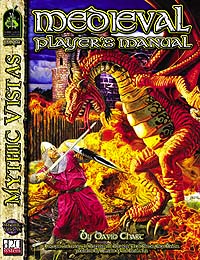
D20 books for Ravenloft
In these columns, I review non-Ravenloft D20 products, in order to pinpoint what can be salvaged for a Ravenloft DM, as presented or with modifications. I also reviewed WotC’s products, here. The d20 market is simply huge and nobody has the time and resources to cover all products. I will only cover the d20 products that are themed with similarity to Ravenloft, or could be used by a Ravenloft DM. Again, these opinions are IMHO, and I do not pretend to present the only possibilities, but I sincerely hope to provide interesting ideas. This column will grow with time! If you want your comments on a D20 book to be posted here as well, send them to me at Joel@FraternityOfShadows.com
Regards,
Joël Paquin
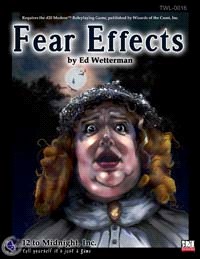 |
Fear EffectsAuthor: Ed Wetterman |
Joel of the Fraternity
This short sized netbook is developing a tool for DMs – how to induce and manage fear effects on PCs. This is an optional tool, for DMs wishing to add the effect of fear or horror to players. Sometimes, a DM can be dismounted by players not showing fear (DM: “The priest finishes his summoning spell and the mighty Hastur makes an appearance in a frightful thunderclap! His 600 feet hulking shape towers over you!” Player of a 1st level fighter: “OK doke. I try to hit him with my sling”). Many people feel that realistically sometimes a PC should turn back and run. This tool should help them. It is of course a good idea to talk with your players about this new option. The main benefits are surprising and unplanned twists to the game, and more occasions of role play, something Ravenloft fans already are aware of.
The severity of the effect is depending on the fear type: minor spook, medium shock and great fright. These categories are simple and well explained, making it easy for a DM to sort the appropriate category. One thing that irks me is that fear and horror are mixed into one category; while for me they are two separate occurrences and should have different effects.
To see if your PC is affected or not by fear, in short, you get a Will save DC 10 (plus or minus check modifiers such as “being alone” or “seeing horrific things happening to a loved one”, etc.). If you fail it, you are affected by a fear effect and you should roll on the random table. One of the good ideas of this option it that if you roll “1” to your Will DC, your fear is increased by one category (a minor spook becomes a medium shock, etc.). On the other hand, if you roll “20”, you are hardened by your inner strength and get bonuses for the remaining of the session on fear checks (this last part is a good option for Ravenloft).
Then you roll a %100 and check the fear effect on the charts. Of course, there is a different column to check the chart according to the fear category your PC faces. The stronger the fear, the stronger the effects. The table lists effects are interesting, and really can enhance a game ex: “better you then me! Attempt to grab a random bystander or ally in an effort to place him between yourself and the object of the Horror check.”, “hysterical laughing” or “nightmares for 1-10 days”, etc. A lot of research seems to have been made to gather and develop these 100 effects, ranging from the mild spook effects to the heavy phobias, compulsions or mental disorder.
The bad part of random effects is that sometimes the effect has no link to what caused it, like if you see a gory scene and get “compulsion to eat only raw meat”. People would not react that way! ;) This said, in the opening part, the author write that is aware that sometimes DMs should reroll since the “what you see is what you get” result would be silly. That’s the only bug with randomization: sometimes you have to roll again for something more appropriate. But it’s not a major problem for me.
A cool thing of this optional tool is the “recovery from permanent effects” discussion. It explains in length how a player can get rid of a permanent madness or compulsion by a treatment with a psychiatrist or a stay in an asylum. The mechanics to deal with these are simple and effective, and open a large range of roleplay opportunities.
For the Ravenloft setting (my area of DMing): the setting of Dread already has its own fear mechanics, for fear, horror and madness checks. This “fear effects” netbook could be a good addition to the fear checks effects, but not for horror or madness checks, since Ravenloft mechanics for these checks are better and more appropriate to the setting.
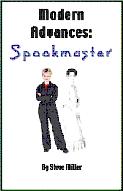 |
Modern Advances: SpookmasterAuthor: Steve Miller |
Joel of the Fraternity
Here’s a short but very interesting book about a new prestige class (“advanced” class, as it’s primarily made for D20 Modern, but it could be adapted to Ravenloft fairly easily). The Spookmaster is a class for people who had a near-death experience. Back from it, they can see and interact with the spirits of the dead. The abilities gained with this class are cool, such as:
Ghost companion (a third level character, with the ghost template, as friend. This ghost has of course its own personality and is free willed. At higher level, telepathic link is gained – see the netbook for details);
Sense Electromagnetic Disruptions: In short: feel if a ghost is present or was present in the area in the last three days;
Identify haunt: In short, get information about a ghost.
Three new feats are well explained and balanced.
The class is followed by a ghost template. This template is fun and some of its abilities could give a cool twist to your next ghost apparition: adjust temperature, corrupting gaze, corrupting touch, etc.
Then the book ends with a NPC, Marion K Bassett, a d20 Modern hero that has her show on TV. With some adaptation about the media (replace TV by newspaper) and background, this NPC could be an interesting MotRD NPC. I think the book as highly recommended: the class is far from being overpowered, and could be easily be integrated in a Ravenloft campaign. It would made a cool NPC, and hey, even a PC. What I like a lot is that role playing opportunities are endless with the class.
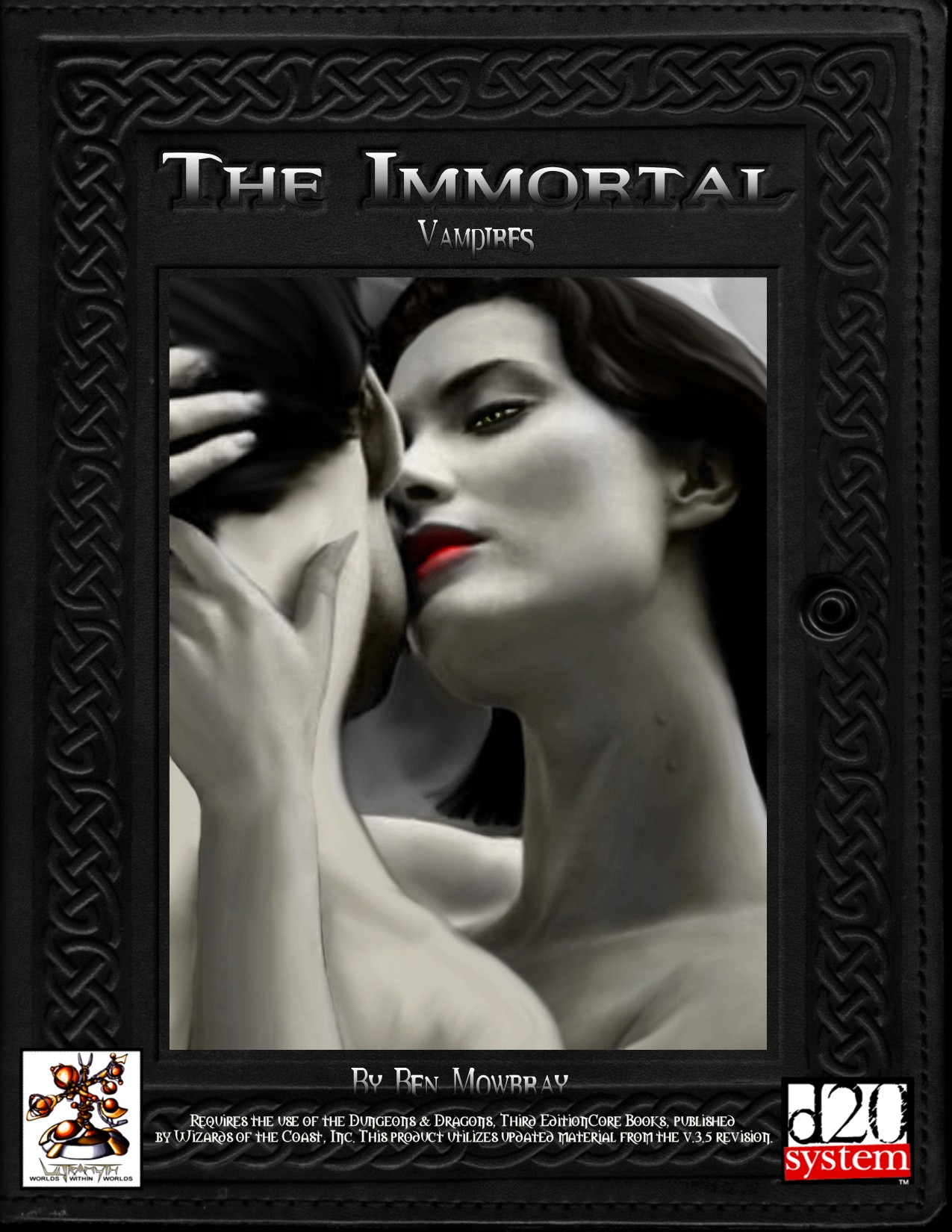 |
The Immortal, a book on vampiresAuthor: Ben Mowbray |
Joel of the Fraternity
This good sized netbook is all about vampires. While not made for Ravenloft in mind, many of its features can be inserted in a Ravenloft campaign. The main thing I liked is that many of these vampire strains are low powered, and easy to adapt to a campaign with proper background.
Ben has read the 1800's vampire novels,as well as modern ones, and he offers many templates derived from literature,like the great Carmillite vampire (from the LeFanu’s Carmilla novel). Theauthor explores many facets of "classic" literature vampirism, each with its ownpersonality and tailored abilities. It also features different vampire folklorefrom our world.
The book content in more details:
- 5 pages on vampire literature review, offering more on vampirism in ancient lore and classic vampire novels.
- 35 pages on the vampire monster, providing more options on roleplaying vampires, feeding, lair, wealth, vampire psychology. This part deconstructs the CR of the monster manual vampire, enabling a DM to tailor a vampire for his own campaign with great ease. It also proposes new vampire powers and weaknesses, using the same method, making it easy to set the CR of a new vampire. The same table is made with age categories, and a list of salient powers with each age category. Follows it is a short discussion on a vampire’s soul, appearance, notes on sleeping and feeding requirement, becoming a vampire, blood draining, etc.
Most of these discussions are interesting to read and offer good options. The list of powers is endless and surely would fit any DM’s need for something new about blood suckers. - 60 pages of new vampire strains follow. 25 types of vampire are discussed, like the Algul (low level encounter: a ghoul-like vampire), Baobban Sith (an enthralling, dancing fey, waiting for you to get charmed to drain you), Cambion (son of an incubus!), the great Carmillite Vampire (a vampire that likes to charm and deceive), Demonic Vampire and Incubus/Succubus, Dhampir, Master Vampire (think Stoker’s Dracula), Nosferatu (think Stoker’s Dracula’s brides), Romantic Vampire (Anne Rice’s vampires), etc. The book covers vampires from the world: Ch’ing Shih (China), Dearg-Due (Celtic), Draugr (Scandinavia), Estrie (Hebrew), Lamia (Greece), Langsuir (Malaysia), Necurat (Romania), Rakshasa (India), Strigoi Mort (Romania), Upier (Poland), Vampir (Serbia), Vrykolakas (Greece), Zmeu (Moldavia).
This material is good inspiration for Ravenloft, but as well good material for MotRD. Most of these monsters are well made and can be easily inserted in Ravenloft, and many can be used with low-level PCs. - The last part of the netbook is about well known vampire NPC (Carmilla, Dracula, Ruthren (from Polidori’s The Vampyre), Varney (from Rymer’s Varney the Vampire) and vampiric gods (the first being Egyptian vampire gods, inspired by Rice I guess). The art is fun, naďve and mostly enhance the book (the Lilith picture is … interesting). The cover is great, I like it a lot.
For Ravenloft: The book is a worthy companion to the VRGttV, as this netbook offers many ideas and 3rd ed stats. Recommended.
It is available at rpg.drivethrustuff.com/ or here to get a Ravenloft discount.
Wolfgand Enrique Kook Camero
The goal of this short manual is to use the d20 system in a RW medieval setting (England, around the time of the crusades, to be more specific), and it makes several modifications and additions to the standard rules to do so, introducing new classes, together with rule additions to make them playable, new skills, feats, etc.
The first problem with the Medieval Player's Manual is its organization: The manual doesn't have different sections on classes, skills, feats, and such. Instead, it starts with a section on Arcane Magic, follows with Divine Magic, goes on with the Church, Art and Philosophy and ends with a historical reference on several important figures of the intended setting, complete with game stats and such. On each section, it introduces classes, skills, feats and monsters as needed, keeping each class in its own package, but making it troublesome to find particular elements to those of us accustomed to a certain order.
The second problem involves its historical accuracy. It's a book about a specific setting, and a big deal of its elements cannot be extrapolated to another setting. DMs and players who are not interested in learning about the catholic church and its doctrines, or about england in the middle ages, may end up ignoring about a third part of the book. Several powers derive from being without sin, as defined by the catholic church, or similar trappings, so to use them in another setting, the entire theological system may have to be used too (Clever DMs may work their way around, by making "Charisms" work for those without taint, as defined in the Heroes of Horror rulebook, or those who retain their LG alignment, or such)
Finally, some of the other changes and additions seem to be intended for "real roleplayers" trying to make a total immersion in a medieval setting by becoming vicars of the Catholic Church, philosophers or artists (With few to no combat possibilities, but with their own systems to create artistic masterworks or philosophical or theological discussions), or by learning alchemy using RW medieval alchemic theories. Players not interested in this immersion may end up being discouraged by the setting, and it doesn't seem to be too much for mixed parties to do, aside from accompanying each other while one of them is in the spotlight.
Aside from these problems, however, most of the new rules are brilliant, and have an excelent flavor that will surely enhance a low-magic setting a lot. Among them:
- A new Astrology skill that will work easily in almost any setting, and which comes along with three feats (Natal Astrology, Political Astrology and Decision Astrology) that will surely enhance it, making it a very interesting option for players who want a flavorful substitute to divination spells.
- A section on folk charms: Simple, pseudo-magical items with minor effects which require a feat to create, and which are usually very crude and simple. Most of them are interesting replacements for abjuration spells, and some give bonuses to dice rolls.
- A section on "Charisms": Powerful feats that are meant as gifts from God to those who are free of sin. Charisms are divided into several categories, from healing to prophecy, and each set seems like an interesting addition to any character who is pure of heart and deed and wants to get the world rid of evil.
In brief, a great book with lots of interesting and flavorful elements, but a little too anchored in the RW middle age to be easy to use as-is in another setting.
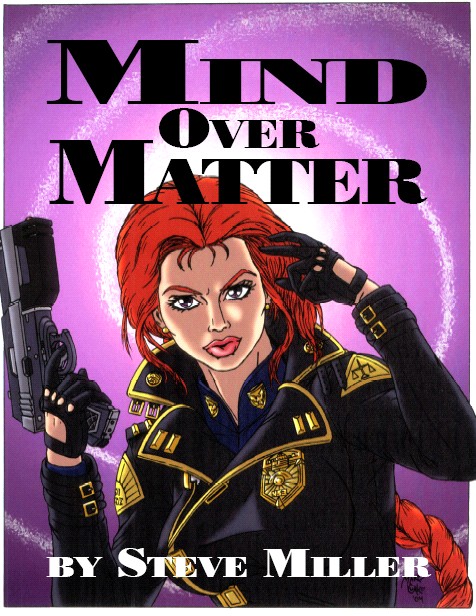 |
Mind over MatterAuthor: Steve Miller |
Joel of the Fraternity
After way too long (blame real life), here’s my review of Steve’s Mind Over Matter book (MoM), an option book for psionic in the d20 system. It is made for any setting in mind, including d20 Modern, so some parts of the book do not apply to Ravenloft (“A television? A computer? A PsiCop? Just the words sound weird to me”, would say Viktor Hazan)
First, I have to say that the MoM system is very simple, compared to other psionic systems in 3rd edition. It is based on feats and skills. Simply put, first, you take the Psychic Ability feat, and this feats enables you to take psionic skills. That’s the beauty of it: just skills. So the system is self limiting: if you take the feat and add ranks in psionic skills, you do not take ranks in other class skills. The consequence is that the MoM system is lower powered then other d20 psionic systems we know. You do not need to be psioniscist to use psionics, but the psionics skills are more subtle.
So you use the skills as often as you use other skills, like Spot or whatever. That means the skills need to be well balanced, of course. They are, for most. For example, the heal psionic skill. You can give a round of curing to everybody with you, including you. On average, you restore 3d4 hit points. For retry, the DC for the same injury is augmented by 10. So you get one round of cure, perhaps two if you’re lucky. It’s not too powerful and still useful.
The following lists the psionic skills included in the book. You’ll notice there is nothing to melt the brains of your opponents, just cool psionic powers to enhance your game. Many great roleplaying opportunities here.
- Astral Projection (should be switched to Ethereal Projection in Ravenloft, with usual limits on domain closure);
- Autohypnosis (great skill: to resist fear, memorize something, tolerate poison);
- Aura Reading (race, health, state of mind and cool new concept: aura strength; Will save to resist it);
- Clairvoyance;
- Empathy;
- Ghost Sight;
- Heal;
- Postcognition (cool skill: get impressions of events that happened in a location);
- Precognition (to see parts of the future and guide your actions);
- Probability Manipulation (influence something in your favor);
- Psychometry (know more information about a person from an object);
- Pyrokinesis (start fire at a distance);
- Spirit Channel (speak with the dead);
- Stabilize Self (when at -1 hp or lower);
- Telekinesis;
- Telepathy.
The book explains in lenght each of these skills, devoting about a third of a page to half a page to each skill.
That said, the bad points: some of the skills still do not seems to be well balanced and can quickly become overpowered.
First example: Pyrokinesis. The skill inflicts 1d6 point of fire per rank in the skill. Let’s say a 6th level rogue with 3 ranks would make 3d6 of fire damage each round. Since a skill can be used round after round, this can be devastating, unless there is a limit to it. The limit imposed to this skill is that 5% of the time, the fire is uncontrolled (as long as it’s on the target, not really a limit in this case) and if you roll “20” on your skill check, you take half of the damage you inflict. So, statistical wise, our 6th level rogue with 25 hit points could inflict up to 120d6 of fire damage before getting seriously hurt (half the damage = 1.5 d6 x 4 times to get to about one hit point x 20 times before getting a backlash). That’s much more powerful then a wiz!
Second example: Spirit Chanel. To speak with the dead, the DC is 15 and the highest limitation is +6 if the dead has been in this sorry state for more then 1,000 years, for a DC of 21. The limitation to this power is a DC increase, unless you take a full minute of quiet meditation to clear your mind. So, a very low skilled person in that ability (say rank 2), with a lot of time in his hand, could get one success every half an hour if he does only that, i.e. try the skill, clear his mind, try again and so on. So if he spend an afternoon on it, our low skilled person could ask 8+ question to a dead person, which is much more powerful than the speak with the dead spell priest spell (limited to once a week). Not to mention taking 20!
That said, the two examples are easy to solve, if you add a time limitation to these, like for example the pyrokinesis skill is limited to a few uses per day only (ex: three times the number of rank you have), and that Spirit Chanel takes one to four hours of meditation to establish contact with the spirit, or similar limitation you can think of.
So, even if one needs to correct a few things, this book is a great addition to the Ravenloft setting and I strongly recommend this book to anyone looking for a painless, more subtle way to introduce psionics to your campaign. I will surely add parts of it in my campaign in the next game.
Highly recommended.
It is sold at www.rpgnow.com and rpg.drivethrustuff.com/
alhoon
A very good book that gives a realistic and interesting view on psionics. As Steve Miller claims it is more about how horror movie psionics are rather than high fantasy. Don't believe him that the psionics in this system are underpowered. Really. Except if you believe that wizard's only powers are fireball, Chain lighting, Horrid wilting etc.
To make a long interesting book short: Instead of psionic powers per level and psionic points, you get them as skills. To even start taking them as cross class, you have to take a feat. Then you advance like any other skill, even taking feats to improve them.
*** Good points ***
- A very realistic and interesting system about psionics. Better than the force system for Starwars
- I got it from DrivethruRPG and it was quite cheap for its quality. Low cost doesn't mean poor quality however!
- Puts the creative juices to work. Sure, Steve Miller proposes enough powers. Sure, the skill cost is steep if you want to advance in many powers. Sure, most of the "classic" oriental monk or Futuristic cop powers are there. But you get more than that. You want to make a psionic power that distrubs the flow of time? You're welcome to do that.
- The rogue feels overshadowed by his pals? He believes his role is primary to unlock doors and detect traps? The fighter needs the "extra something" to make him different than the typical "Power attack, cleave, weapon focus, weapon specialization" guy? Solved. The psionics here are for ALL classes.
- You can give your PCs a surprise when they smirk when it is revealed that the main villains are "only" human thieves.
- Gives a certain atmosphere that adds to mystery in my opinion.
*** Bad Points ***
- Steve Miller's comments about "not as powerful as magic" and " do not use them along with arcane or divine magic" etc comments. We are talking about rogues and fighters and rangers here. :) If the ranger of the party wants to dish out fireballs and the party's rogue to neutralize poisons, then:
- Yes, Mind over Matter won't solve that problem.
- the first player should take a wizard and the second a cleric.
- Opposite to Steve Miller's opinion, I believe the psionic rules presented are too powerful. OK the ranger cannot throw fireballs (at least not safely). Still with 2 feats a few skill points he can safely scout ahead for miles in an invisible, incorporeal form. And human rangers with intelligence 14 have a few skill points to spend.
- While it can be used in any kind of D20 game, it is written with more advanced technological eras in mind. Not the rules, but the examples, pictures, etc.
- Needs some work from the DM to tone the psionics down. Actually there
a way for the ranger to dish out fireballs (even if not safely). There a way for the rogue to neutralize poisons (even if not reliable to work when you most need it).
NOTE: I have NOT tested the system on a game yet! Perhaps Steve Miller is right and I'm wrong. - Doesn't have mind flayers in it! Yes, I know it is OGL so he could not include mind flayers.
- All your friends will be jealous of you for having this book.
For Ravenloft games especially I recomend it because:
- It probably fixes some of the power problems that arise in higher levels by the lack of multiple magic items.
- Encourages players to put that 15 in intelligence and that 12 in wisdom instead of the other way around and encourages mystery-solving and thinking instead of hacking.
- Gives another tool for the DM to help novice players solve mysteries or getting any kind of player involved in a story.
Final opinion: A very good book, 4 out of 5 stars. No, it is not that useful for the wizard player. Still the rogue character that is actually a detective and not a thief has a way to spend those extra skill points. You can make really memorable detectives of the supernatural horrors with this book. I believe that a DM of Ravenloft will find it useful to create nice and memorable villains and the players for getting an edge. Remember: The rogue class was never about fireballs or healing. It is a balanced class in itself. Psionics just give the characters the "extra touch" and edge.
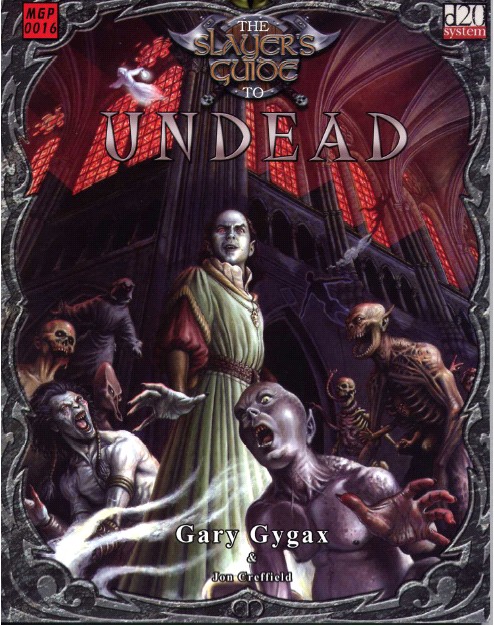 |
Slayer’s Guide to the UndeadAuthor: Gary Gygax and John CreffieldType: Accessory – undead Format: 128 pages, paperback Release date: 2002 Summary of content: Book in the Slayer’s Guide tradition, exploring undead creatures. Publisher: Mongoose. Rating: * |
Joel of the Fraternity
As much as I like the Slayer’s Guide serie in general, I did not like this book. Written by good old Gygax (yeah, right) and John Creffield (do you think we should we reverse this order?), the book is nearly useless, and full of no imagination templates.
But let’s go into details:
The first parts are about Orcus, the demon lord of Undead, about the senses of undead, etc. Nothing more then you could read in the WotC Monster Manual or quickly extrapolate from it. It is full of great stuff like “Undead are immune to virtually all spells that affect the mind (…) Some have hypothesised that the undead do not have working brains and thus magic cannot affect them.” First, it is false (wights, ghouls and vampires still have their brains and it’s not rotting) and second, the answer to that phenomenon is well known: it is simply because their mind is warped by undeath. The book is full of similar simplifications that do not stand under the most simple analysis.
Then you have templates. Poor! They do not propose anything, it’s just that, i.e. for a skeleton – change the die to d12, speed: same as base creature, etc. Who really needed that? Poor page use, more like filling to me. Anybody could have done something similar without the book. Astonishingly poor grasp of basic concepts: a new undead, the skassassin, is an unwilled undead executioner able to follow its target anywhere on the same plane, hide and use camouflage. Mindless like a skeleton or a zombie, huh? This error would have been laughed at in any fan-made netbook…
The other undead covered by this book are bodak, devourers, ghouls, ghasts, mohrgs, mummies, wights, allips, ghosts, shadows, spectres, wraiths, liches, vampires: other great templates and bland flavour text. The section on mummy rectifies a funny mistake of the first edition of D&D: “Zagig” admits having done a mistake by saying mummies derive their magic from positive energy, and that it should be from negative energy instead. Great 1st edition mistake corrected. There is a recurring fiction about a prostitute finding a book about undead in the things of a sleeping client. She reads it and is lured to more power (yawn).
The cover is quite cool, but it nearly stops there. The inside cover art is gory, disgusting and tasteless. It is absolutely repulsive and unneeded, and the illustration of page 34 (and others) reeks of a pimple-faced teen drawer. The end adventure is cheesy to the max: a giant bodak-eagle? A spider-wight? A young gold-dragon-wight? But of course! Useless.
If you really want to read it, get a very cheap copy. Not recommended, even for a fantasy setting. Get the Van Ricten’s Guides or Libris Mortis, you won’t get filling in these.
For each review, please vote for the product you are reviewing using a scale of five, with one being awful and five being excellent.
Please send your Reviews of art, books, movies, music, television shows, and video games to submissions@fraternityofshadows.com
